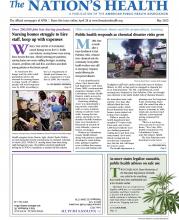
Biden’s fiscal year 2024 budget proposal includes a new plan for national paid family and medical leave. The program would provide up to 12 weeks of leave for workers to care for their own illness, connect with a new child or tend to a sick family member.
Photo by Phynart Studio, courtesy iStockphoto
“An illness-care system leaves our most vulnerable families behind. A wellness-care system invests in providing the full spectrum of health care to America.”
— Xavier Becerra
President Joe Biden’s new fiscal year 2024 budget promises much-needed gains for public health programs, relief for Americans struggling with rising costs and new initiatives to help improve the health of vulnerable populations.
Released March 9, the proposed $6.8 trillion budget pledges to reduce the national deficit while boosting U.S. work on climate change, maternal health, drinking water safety, health workforce shortages, suicide prevention, pandemic preparedness and more.
The budget would provide $144 billion in discretionary funding for the U.S. Department of Health and Human Services, including $11.6 billion for the Centers for Disease Control and Prevention, nearly $2.4 billion more than fiscal year 2023. The proposal also recommends $9.2 billion in discretionary funding for the Health Resources and Services Administration.
“The proposed budget rightly continues its focus on the critical need to strengthen the nation’s public health infrastructure, workforce and pandemic preparedness capabilities,” APHA Executive Director Georges Benjamin, MD, said in a news release.
Among the many health-related measures in the budget is a $325 billion plan to establish national paid family and medical leave. The program would provide up to 12 weeks of leave for workers to care for family members, connect with a new child or tend to an ill family member.
Because of current rules under the Family Medical Leave Act regarding length of employment, numbers of hours worked and employer size, only 56% of U.S. employees are currently eligible for paid FMLA leave. The disparity has a greater impact on single-parent households and low-wage workers, who are more likely to be people of color. Also to shore up worker health, the budget calls for at least seven days of paid sick leave for every employee.
“Enacting a national paid family and medical leave program that covers all workers and recognizes all families — as well as paid sick leave — is key to advancing economic, gender and racial equity in the United States,” said Sherry Leiwant, JD, co-president of A Better Balance, a nonprofit that advocates for workers. “It will also be beneficial for public health and boost our economy.”
The budget gives special attention to strengthening and growing the U.S. health care workforce. It would expand HRSA’s National Health Service Corps, which provides scholarships and loan repayments in exchange for work in underserved areas, and fund training and development of nursing, rural and behavioral health providers. A 2022 study found at least 80,000 new public health workers are needed at the state and local level for health departments to provide core services.
Another measure proposed in the president’s budget is a new federal health insurance plan described as “Medicaid-like” that would be available to low-income people who live in the 11 states that have not expanded Medicaid coverage. Research has shown that the failure to expand Medicaid in those states led to almost 16,000 premature deaths over a four-year period alone. The Biden budget would also incentivize states that have expanded Medicaid to maintain coverage.
“We are moving health care in this country from an illness-care system to a wellness-care system,” HHS Secretary Xavier Becerra said during a March news conference. “An illness-care system leaves our most vulnerable families behind. A wellness-care system invests in providing the full spectrum of health care to America, whether in our homes, our local schools or our community centers.”
Within HHS, the budget proposal for the Substance Abuse and Mental Health Services Administration contains a request for a high-level name change. If approved by Congress, the word “abuse” would be changed to “use,” in SAMHSA’s name and the names of its centers, reducing “the historic stigma that too often has proven to be a barrier to seeking and receiving care,” the agency said in a news release.
Programs that would receive funding increases at SAMHSA include the Project Advancing Wellness and Resiliency in Education, which identifies children in need of mental health services through their schools; the new 988 Suicide and Crisis Lifeline, which answered 2.1 million requests in its first six months alone last year; and the State Opioid Response Grant Program, which provides states and territories with funding to address the ongoing opioid crisis.
Other measures in the budget would address public health issues such as:
Climate change
Invest more than $24 billion to help build community resilience to climate change-related disasters such as floods, wildfires, extreme heat and drought.
Provide nearly $1.8 billion for EPA programs that work toward environmental justice for communities that bear the brunt of toxic pollution and climate change.
Tackle the human health impacts of climate change, with increases for CDC’s Climate and Health Program and for climate and health research at the National Institutes of Health.
Community health
Provide $8.1 billion in discretionary resources for the Indian Health Service, $1 billion for the Department of Housing and Urban Development to support tribal work on housing conditions, $2.8 billion to support water safety through the Indian Water Rights Settlement Completion Fund, and $48 million for tribal climate resilience and adaptation work at the Department of the Interior.
Allot more than $4 billion for EPA work to upgrade drinking water and wastewater infrastructure, with a focus on eliminating lead service lines and decreasing disparities;
Increase homelessness assistance grants by $116 million in support of the Federal Strategic Plan to End Homelessness and provide $505 million for housing for people with AIDS.
Earmark $600 million for CDC to support core public health infrastructure activities at the state, tribal, local and territorial levels, an increase of $250 million.
Health care
Create a CDC program that would provide uninsured adults with access to routine and emergency vaccines.
Cap the prices of insulin products at $35 for a monthly prescription.
Work to lower the nation’s maternal mortality rate by expanding rural programs, offering implicit bias training for health care providers, creating pregnancy medical home demonstration projects and supporting the perinatal health workforce.
Require all health plans to include benefits for mental health and substance use disorders and makes sure plans offer a sufficient network of behavioral health providers.
Provide $30 million to help prevent closures of rural hospitals and earmark dedicated funding to rural health clinics and communities to address higher rates of suicide and overdose deaths.
Boost funding for the Title X Family Planning Program, which provides affordable birth control and reproductive health care to people with low incomes, after years of flat funding.
“We are grateful to see that this budget recommends a strong and needed investment in safety net family planning providers, an essential component of the public health workforce,” said Clare Coleman, president and CEO of the National Family Planning and Reproductive Health Association, in a news release. “The proposed funding would support millions of people having access to preventive health care, including contraceptive care, STI and HIV services, cancer screenings and more.”
Family health
Expand the Child Tax Credit to $3,000 per child for children 6 and older and to $3,600 per younger child. An expanded tax credit put into place during the COVID-19 pandemic drove down U.S. poverty rates and lifted more than 2 million children out of poverty.
Create a new first-generation down payment assistance program to address racial and ethnic gaps in homeownership.
Double funds for the Family Violence Prevention and Services program and the National Domestic Violence Hotline. The funding would include support for a demonstration project that reaches survivors of interpersonal violence during interactions with housing, substance use and child welfare services.
Provide guaranteed assistance for the 20,000 youth who age out of foster care annually and work to place more foster children with relatives or other adults who have an existing bond with them.
Increase funding for the Low Income Home Energy Assistance Program, which helps people weatherize homes and lower heating and cooling costs, and allows states to help people pay water bills.
“As the nation grapples with the impacts of climate change and extreme weather, which disproportionately impacts communities of color and lower-income households, LIHEAP is especially important to creating greater equity,” January Contreras, assistant secretary of the Administration for Children and Families, said in a March news release on new LIHEAP grant awards.
Whether the president’s funding and programming proposals make it into law is now in the hands of Congress, as legislators spend the months ahead discussing and revising the budget. Advocates can help influence the outcome by contacting their elected officials throughout the budget process and by joining APHA as it speaks for public health priorities.
“We laud the administration’s continued focus on critical public health priorities and look forward to working with them and all members of Congress to support these long overdue investments,” Benjamin said.
For more on the “Budget of the U.S. Government, Fiscal Year 2024,” visit www.whitehouse.gov/omb/budget.
- Copyright The Nation’s Health, American Public Health Association









